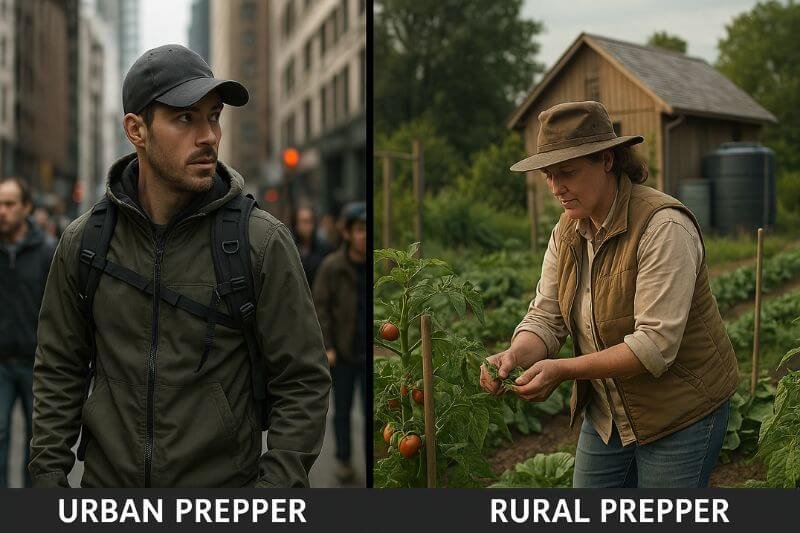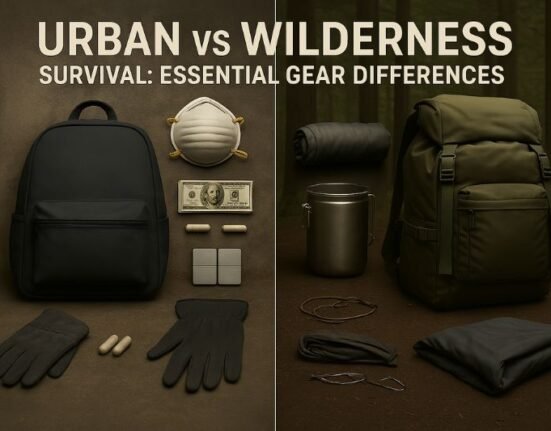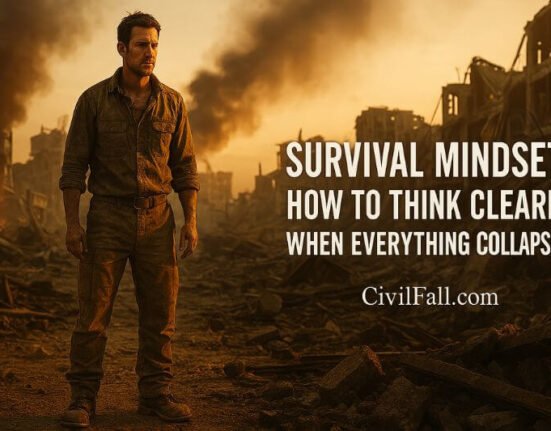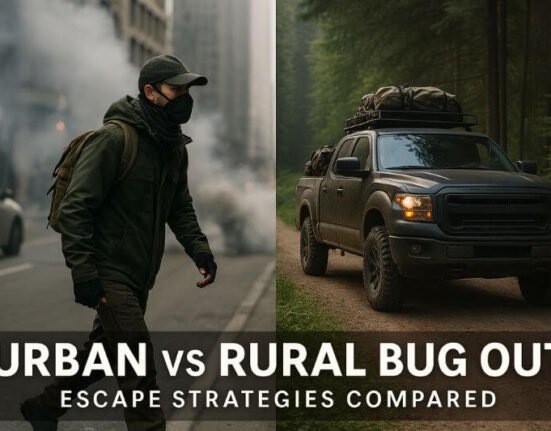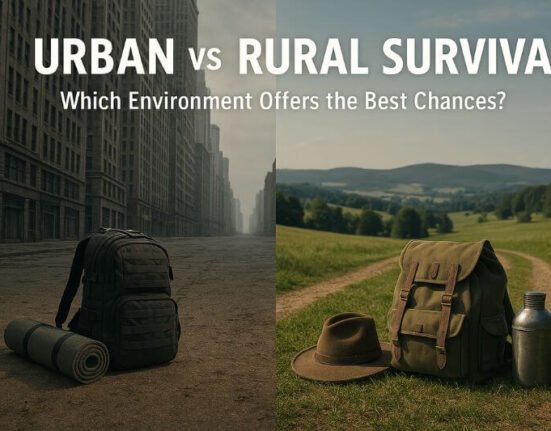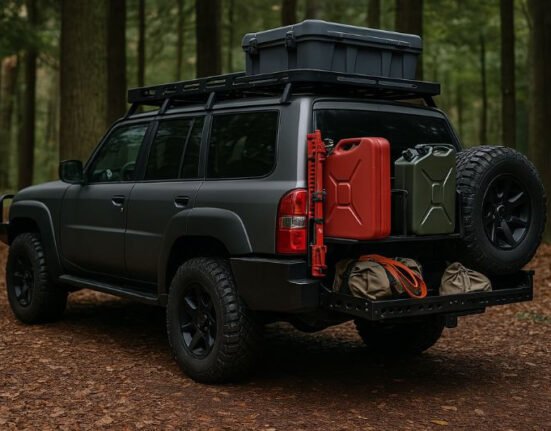🧭 Part 1: The Core Differences Between Urban and Rural Prepping – Environments Define Strategy
Prepping isn’t one-size-fits-all. Your environment defines everything—from the gear you carry to the skills you need to survive. That’s why understanding the core differences in urban vs rural prepping is one of the most critical decisions a survivalist can make.
Failing to prep according to your environment can get you killed. Overpreparing the wrong way can drain your resources. This section dives into how prepping is shaped by your surroundings, and why choosing the right strategy isn’t optional—it’s survival.
🏙️ Urban Prepping: Planning Inside the Collapse
Urban prepping is about speed, stealth, and scarcity management. When millions live in tight quarters, panic spreads fast and everything becomes a competition—food, fuel, medicine, even safe space.
Key Characteristics of Urban Prepping:
- High population density = increased human threats
- Tactical navigation (elevators, subways, stairwells)
- Dependence on grid systems (electricity, water, communication)
- Short-term bug-in with fallback bug-out plan
- Emphasis on concealment, mobility, and adaptability
“In cities, you don’t prep for nature—you prep for people. And they’re more unpredictable than any storm.”
— Selco Begovic, urban survivor, Bosnia
🧠 Urban prepping is a compressed model—focused on surviving the first 72 hours with intensity, then transitioning into escape or resupply strategy.
🌄 Rural Prepping: Building the Long Game
Rural prepping focuses on sustainability, space, and independence. There’s less human threat, but more reliance on your ability to generate and maintain systems—from food to power to medical care.
Key Characteristics of Rural Prepping:
- Wide space and isolation = lower threat density, slower emergency response
- Self-reliant systems: wells, solar, gardening, livestock
- Long-term bug-in focus with layered defense
- Community cooperation rather than avoidance
- Emphasis on production over consumption
“In the country, the collapse doesn’t rush in. It creeps. And if you’re not ahead of it, you’ll drown in your own land.”
— Joanna Horne, homestead prepper & author
🧠 Rural prepping is infrastructure-focused—your survival is tied to your ability to run a micro-ecosystem under pressure.
⚖️ Urban vs Rural: Side-by-Side Comparison
| Category | Urban Prepping | Rural Prepping |
|---|---|---|
| Threat Type | Looters, mobs, infrastructure collapse | Isolation, supply scarcity, natural threats |
| Priority Focus | Security, mobility, concealment | Sustainability, redundancy, production |
| Food Strategy | Stockpile + scavenge | Grow + preserve |
| Water Access | Stored + scavenged + filtration | Wells + rainwater + ponds |
| Medical Plan | First aid + rapid bug-out to hospital | Self-treatment + herbal/long-term stock |
| Bug-Out Plan | High priority | Only if land becomes compromised |
| Gear Style | Lightweight, discreet, portable | Durable, functional, long-use |
🎯 Prepper Psychology: Environment Shapes Mindset
Even your mental approach to prepping changes depending on where you are:
Urban Mindset:
- “I need to escape fast if things go south.”
- “Everyone around me could become a threat.”
- “Information is as important as food.”
Rural Mindset:
- “I need to sustain my family here for months or more.”
- “We’re on our own—no one’s coming.”
- “Preparation is a lifestyle, not an emergency response.”
“Urban prepping is about reaction. Rural prepping is about prevention.”
— Clay Martin, Green Beret and survival instructor
📋 Quick Self-Assessment: Where Do You Stand?
Answer honestly:
- Do you live within 15 minutes of a grocery store?
- Is your home surrounded by 20+ other residences within a few blocks?
- Do you rely on city services for water, power, waste?
If yes to most → You need an urban prepping strategy.
Now ask:
- Do you grow food or raise animals?
- Do you have a well, septic system, or solar setup?
- Can you go days or weeks without outside help?
If yes to most → You need a rural prepping strategy.
🧠 Some people live in transitional zones (suburban, exurban). For them, a hybrid prepping model might be the most realistic path.
🔧 Part 2: Gear, Skills, and Tactics – How Urban and Rural Prepping Diverge in Practice
Now that we’ve explored the environmental and psychological foundations of urban vs rural prepping, it’s time to look at what this means in action.
From the backpack you carry to the skills you train, your entire prep strategy must reflect your terrain. Prepping for the wrong environment isn’t just inefficient—it can get you hurt or expose you when you need stealth most.
🎒 Urban Prepping Gear: Portable, Low-Profile, Tactical
In cities, everything is about mobility and invisibility. Your gear needs to help you move fast, stay unnoticed, and deal with close-proximity threats.
🧳 Core Urban Prepper Gear List:
- Compact tactical flashlight (strobe for defense, high-lumen for navigation)
- Crowbar or mini pry tool (urban scavenging access)
- Foldable water containers + filtration straw
- Emergency respirator mask (pollution, smoke, crowd control gas)
- Cash (small bills) + burner phone
- Maps with marked escape routes and footpaths
- Urban camo clothing (dark neutral, no logos, blend in)
🧠 Golden Rule: If your gear attracts attention, it’s a liability—not an asset.
🧰 Rural Prepping Gear: Durable, Repairable, Sustainable
In remote areas, you need gear that will last, perform, and adapt to a slower, more rugged pace. Stealth matters less than function and longevity.
🌾 Core Rural Prepper Gear List:
- Crosscut saw, axe, sharpening tools
- Solar-powered lanterns and chargers
- Heavy-duty boots, gloves, thermal gear
- Pressure canner + food preservation kits
- Livestock feed storage and grain grinders
- HAM radio + off-grid antennas
- Spare parts (pipes, fuel lines, wire, gaskets)
🧠 Golden Rule: If it breaks and can’t be fixed on-site, it’s a future problem.
🛠️ Skills That Matter: City vs Countryside
Urban survivalists need fast, reactive, evasive skills.
Rural survivalists need slow, sustainable, generational knowledge.
📍 Urban Skills to Train:
- Evading checkpoints and roadblocks
- Scavenging from abandoned sites safely
- Lockpicking and bypassing barriers
- Apartment defense and stealth movement
- First aid under stress (bleeding, trauma)
- Grey man blending and crowd manipulation
🌲 Rural Skills to Train:
- Gardening and soil regeneration
- Animal husbandry and veterinary basics
- Firewood harvesting and woodstove maintenance
- Water filtration, well repair, irrigation setup
- Long-term food preservation (curing, canning, fermenting)
- Tool repair, forging, small engine maintenance
“Urban preppers survive on instinct. Rural preppers survive on systems.”
— Daniel Tate, former U.S. Forest Service field instructor
⚔️ Tactical Prep: Security and Defense Differences
The threats are different. So your defense posture must be too.
Urban Defense:
- Barricades, stealth, and misleading cues (appear unprepared)
- Limited-range tools (pepper spray, batons, small calibers)
- Avoid conflict at all costs; stay mobile
- Light-and-sound discipline at night
- Rooftop access and multi-level escape plans
Rural Defense:
- Layered perimeter (natural and constructed)
- Long-range surveillance and marksmanship
- Guard animals, motion sensors, patrol rotation
- Community watch structures and coded comms
- Concealed storage and fallback shelters
🧠 Urban prep is avoidance through invisibility. Rural prep is prevention through dominance of terrain.
🧱 Shelter Strategy Breakdown
| Factor | Urban Prepping | Rural Prepping |
|---|---|---|
| Primary Shelter | Apartment or temporary safehouse | Cabin, homestead, or fortified farm |
| Backup Shelter | Underground spots, abandoned buildings | Secondary buildings, bunkers, trailers |
| Threat Approach | Vertical (stairs, elevators, windows) | Perimeter (fields, trees, gates) |
| Camouflage Priority | High – blend in with population | Medium – blend into natural surroundings |
| Fire & Noise Risk | High – attracts mobs | Medium – visible at distance, but sparse |
🧭 Navigation & Movement Strategy
In cities, GPS failure means you need to know your city by memory.
- Learn back alleyways, utility tunnels, rooftops
- Avoid choke points like bridges, train stations
- Blend into panicking crowds without joining them
In rural settings, maps and land literacy are your lifeline.
- Know where creeks rise or dry
- Track wind patterns, animal movement
- Use stars, trees, and elevation for orientation
🧠 Rule of thumb: An urban prepper needs to escape. A rural prepper needs to endure.
🧠 Part 3: Bridging the Gap – Hybrid Prepping, Critical Mistakes, and Choosing Your Strategy
Not everyone lives in a purely urban or rural environment. Some of us are in suburban zones, small towns, or live urban lives with rural fallback plans. That’s where hybrid prepping comes in—a flexible strategy that borrows the best of both worlds.
In this final section, we’ll explore how to integrate urban and rural prepping models, the biggest mistakes people make when switching between environments, and how to lock in the right prepping approach for your reality.
🔄 Hybrid Prepping: The Best of Both Worlds?
Hybrid prepping means preparing to adapt to different scenarios and terrains. It’s ideal for:
- Suburban residents: Too dense for rural tactics, too quiet for urban chaos
- Urban dwellers with rural bug-out locations
- Preppers who work in the city but live semi-rural
🔧 Key Elements of a Hybrid Strategy:
- Urban-ready EDC gear + rural-level long-term supplies
- Flexible shelter options: city apartment + rural cabin/camp
- Redundant food systems: store + scavenge + grow
- Bug-out bag that includes both stealth and sustainability gear
- Escape routes pre-mapped from urban to rural zones
“Hybrid preppers don’t panic—they pivot.”
— Thomas Harlan, survival systems consultant
⚠️ Critical Mistakes to Avoid in Urban vs Rural Prepping
Too many preppers fail because they prep for fantasy scenarios—not real threats. Let’s break down some of the most common failures.
🚫 Urban Prepper Pitfalls:
- Overpacking bug-out bags (slows you down)
- Ignoring water storage (tap dries up in hours)
- Relying on GPS or digital tools only
- Assuming you’ll loot supplies—so does everyone else
- Using visible tactical gear = target on your back
🚫 Rural Prepper Pitfalls:
- Neglecting perimeter security (“nobody knows we’re here…”)
- Stockpiling without rotation (spoiled food, expired meds)
- Lack of medical training or supplies
- Assuming help will come (it won’t, not fast)
- Building but not training (a garden you can’t maintain is dead weight)
🧠 Mistake-proof prepping means constantly testing, rotating, and adapting your plan.
📈 How to Choose the Right Prepping Strategy for You
Ask yourself:
- Where will you likely be when a crisis hits? If it’s your workplace in the city → Urban tactics take priority.
- Where do you feel safest and most capable? If it’s your land or off-grid cabin → Rural skills take priority.
- Can you defend and supply your current location? If yes → Fortify and stay.
If no → Build a bug-out strategy to somewhere that you can. - Do you have a second location? If yes → Pre-stage gear and build redundancy.
If not → Focus on flexibility and stealth.
“Prepping isn’t about hoarding—it’s about positioning. The right skills in the wrong place still get you killed.”
💡 Final Survival Strategy Matrix
| Profile | Best Fit Strategy |
|---|---|
| City worker, no vehicle | Urban stealth, bug-in, fast evac plan |
| Rural homeowner | Self-reliant sustainability |
| Suburban commuter | Hybrid plan, 3-day transition kit |
| Parent with kids | Shelter-in-place + bug-out fallback |
| Elderly or disabled prepper | Strong local network + home fortification |
✅ Summary: Urban vs Rural Prepping – Strategic Recap
| Prep Element | Urban Focus | Rural Focus |
|---|---|---|
| Threat Response | Fast escape, stealth, crowd management | Area control, surveillance, defense |
| Gear Philosophy | Lightweight, concealed, EDC-based | Heavy-duty, repairable, sustainable |
| Food System | Stockpile + scavenge | Grow + preserve |
| Water Access | Stored + scavenged | Wells, rain, surface |
| Defense | Passive + urban camouflage | Active perimeter + layered defense |
| Community | Avoid crowds, form micro alliances | Join/lead homestead network |
🧠 You don’t need to pick a side—you need to prepare realistically, based on where you are, who you’re with, and what you know.
👉 Download the Prepping Strategy Self-Assessment PDF
👉 Explore our Survival Supply System Guide
👉 Read: Bug Out Route Planning – Tools, Maps, and Mistakes to Avoid
❓ FAQ – Urban vs Rural Prepping
Q1: Can I prep for both urban and rural scenarios at once?
Yes, through a hybrid strategy. Start by covering universal basics (water, food, first aid), then build terrain-specific layers.
Q2: Is bugging out always better than sheltering in place?
Not always. In cities, it’s often necessary. In rural zones, staying and defending is usually safer—if your setup is secure.
Q3: What if I live in a suburban area?
You’ll need to blend strategies. Focus on discretion (urban) but invest in long-term sustainability (rural). Pre-position supplies in case roads clog.
Q4: Is it worth buying land to prep?
Yes—if you can maintain and defend it. Land = freedom, but only if paired with skills and security.









